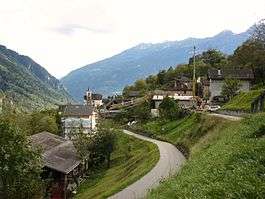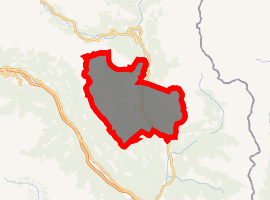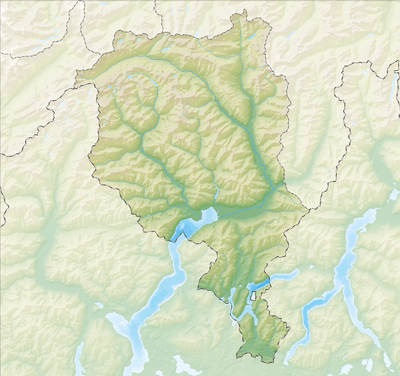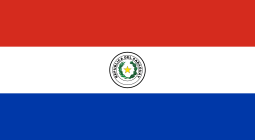Acquarossa, Switzerland
Acquarossa is the capital of the district of Blenio in the canton of Ticino in Switzerland.
Acquarossa | |
|---|---|
 Largario village | |
 Coat of arms | |
Location of Acquarossa 
| |
 Acquarossa  Acquarossa | |
| Coordinates: 46°27′N 8°56′E | |
| Country | Switzerland |
| Canton | Ticino |
| District | Blenio |
| Government | |
| • Mayor | Sindaco |
| Area | |
| • Total | 61.7 km2 (23.8 sq mi) |
| Elevation | 528 m (1,732 ft) |
| Population (2018-12-31)[2] | |
| • Total | 1,808 |
| • Density | 29/km2 (76/sq mi) |
| Postal code | 6716 |
| SFOS number | 5048 |
| Localities | Acquarossa, Dongio, Marogno, Motto Blenio, Corzoneso Piano, Corzoneso, Casserio, Cumiasca, Leontica, Comprovasco, Lottigna, Prugiasco, Castro, Traversa, Marolta, Ponto Valentino, Largario |
| Surrounded by | Olivone, Aquila, Torre, Malvaglia, Ludiano, Sobrio, Cavagnago, Anzonico, Faido |
| Website | http://www.acquarossa.ch SFSO statistics |
The municipality was created on 4 April 2004 by a merger of Castro, Corzoneso, Dongio, Largario, Leontica, Lottigna, Ponto Valentino and Prugiasco. The village Acquarossa was located in Lottigna. The name of the new community was selected from the one located at its centre: Aquarossa, a tourist resort.
History
Castro is first mentioned in 1200 as Castri.[3] Corzoneso is first mentioned in 1210 as Cursonexe.[4] Dongio is first mentioned in 1188 as Deuci.[5] Largario is first mentioned in 1207 as Largario.[6] Leontica is first mentioned in 1204 as Levontega.[7] Lottigna is first mentioned in 1201 as Lotingnia.[8] Ponto Valentino is first mentioned in 1200 as Ponto Varentino. In German it was known as Punt.[9] Prugiasco is first mentioned in 1209 as Puliçasco and it was mentioned in 1409 as Pruxiascho.[10]
Between 1906 and 1973, Acquarossa was linked to Biasca, and its station on the Gotthard railway, by the metre gauge Biasca–Acquarossa railway.[11]
Geography

Acquarossa is located in the Blenio Valley. The surrounding communities are, starting North, following the hands of a watch: Olivone, Aquila, Torre, Malvaglia and Ludiano, as well as Sobrio, Cavagnago, Anzonico and Faido in the district of the Leventina.
Demographics
Acquarossa has a population (as of December 2018) of 1,808.[12] As of 2008, 10.4% of the population are foreign nationals.[13] Over the last 10 years (1997–2007) the population has changed at a rate of 2.4%.
Most of the population (as of 2000) speaks Italian (88.1%), with German being second most common ( 7.0%) and Albanian being third ( 1.6%).[14] As of 2008, the gender distribution of the population was 49.4% male and 50.6% female. The population was made up of 805 Swiss men (43.7% of the population), and 104 (5.6%) non-Swiss men. There were 851 Swiss women (46.2%), and 81 (4.4%) non-Swiss women.[15]
In 2008 there were 7 live births to Swiss citizens and births to non-Swiss citizens, and in same time span there were 23 deaths of Swiss citizens and 1 non-Swiss citizen death. Ignoring immigration and emigration, the population of Swiss citizens decreased by 16 while the foreign population decreased by 1. There was 1 Swiss man and 3 Swiss women who emigrated from Switzerland. At the same time, there were 2 non-Swiss men and 5 non-Swiss women who immigrated from another country to Switzerland. The total Swiss population change in 2008 (from all sources) was a decrease of 13 and the non-Swiss population change was a decrease of 1 people. This represents a population growth rate of -0.8%.[13]
The age distribution, as of 2009, in Acquarossa is; 153 children or 8.3% of the population are between 0 and 9 years old and 204 teenagers or 11.1% are between 10 and 19. Of the adult population, 176 people or 9.6% of the population are between 20 and 29 years old. 218 people or 11.8% are between 30 and 39, 282 people or 15.3% are between 40 and 49, and 209 people or 11.4% are between 50 and 59. The senior population distribution is 246 people or 13.4% of the population are between 60 and 69 years old, 178 people or 9.7% are between 70 and 79, there are 175 people or 9.5% who are over 80.[15]
As of 2000 the average number of residents per living room was 0.54 which is fewer people per room than the cantonal average of 0.6 per room. In this case, a room is defined as space of a housing unit of at least 4 m2 (43 sq ft) as normal bedrooms, dining rooms, living rooms, kitchens and habitable cellars and attics.[16] About 63.8% of the total households were owner occupied, or in other words did not pay rent (though they may have a mortgage or a rent-to-own agreement).[17]
As of 2000, there were 730 private households in the municipality, and an average of 2.3 persons per household.[14] The vacancy rate for the municipality, in 2008, was 0.12%. As of 2007, the construction rate of new housing units was 3.2 new units per 1000 residents.[14]
Election
In the 2007 federal election the most popular party was the CVP which received 36.35% of the vote. The next three most popular parties were the FDP (25.24%), the Ticino League (15.35%) and the SP (13.48%). In the federal election, a total of 555 votes were cast, and the voter turnout was 38.9%.[18]
In the 2007 Ticino Gran Consiglio election, there were a total of 1,446 registered voters in Acquarossa, of which 771 or 53.3% voted. 14 blank ballots and 1 null ballots were cast, leaving 756 valid ballots in the election. The most popular party was the PPD+GenGiova which received 196 or 25.9% of the vote. The next three most popular parties were; the PLRT (with 151 or 20.0%), the SSI (with 131 or 17.3%) and the LEGA (with 127 or 16.8%).[19]
In the 2007 Ticino Consiglio di Stato election, there were 6 blank ballots and 1 null ballots, which left 764 valid ballots in the election. The most popular party was the PPD which received 198 or 25.9% of the vote. The next three most popular parties were; the LEGA (with 173 or 22.6%), the PLRT (with 143 or 18.7%) and the PS (with 121 or 15.8%).[19]
Education
In Acquarossa about 64.3% of the population (between age 25-64) have completed either non-mandatory upper secondary education or additional higher education (either university or a Fachhochschule).[14]
In Acquarossa there are a total of 305 students (as of 2009). The Ticino education system provides up to three years of non-mandatory kindergarten and in Acquarossa there are 36 children in kindergarten. The primary school program lasts for five years and includes both a standard school and a special school. In the municipality, 93 students attend the standard primary schools and 4 students attend the special school. In the lower secondary school system, students either attend a two-year middle school followed by a two-year pre-apprenticeship or they attend a four-year program to prepare for higher education. There are 87 students in the two-year middle school and in their pre-apprenticeship, while 20 students are in the four-year advanced program.
The upper secondary school includes several options, but at the end of the upper secondary program, a student will be prepared to enter a trade or to continue on to a university or college. In Ticino, vocational students may either attend school while working on their internship or apprenticeship (which takes three or four years) or may attend school followed by an internship or apprenticeship (which takes one year as a full-time student or one and a half to two years as a part-time student).[20] There are 11 vocational students who are attending school full-time and 47 who attend part-time.
The professional program lasts three years and prepares a student for a job in engineering, nursing, computer science, business, tourism and similar fields. There are 7 students in the professional program.[21]
Employment
Watchmaking workshops and small watch companies, e.g. Adriatica in Dongio, provide jobs to a good part of the population.
As of 2007, Acquarossa had an unemployment rate of 3.13%. As of 2005, there were 99 people employed in the primary economic sector and about 43 businesses involved in this sector. 155 people are employed in the secondary sector and there are 27 businesses in this sector. 472 people are employed in the tertiary sector, with 62 businesses in this sector.[14]
Of the working population, 4.4% used public transportation to get to work, and 65% used a private car.[14]
As of 2009, there were 3 hotels in Acquarossa.[22]
Places of interest
Well above Prugiasco stands the Romanesque church of San Carlo di Negrentino (up to 1702: cant "Sant' Ambrogio"), begun in the 11th century and completed in the 12th. It is noted for its Romanesque and Gothic frescoes.
International relations
Acquarossa is twinned with the following cities (date of agreement shown in parentheses).[23]

Historical Population
The historical population is given in the following table:
| Year | Population Castro[3] |
Population Corzoneso[4] |
Population Dongio[5] |
Population Largario[6] |
Population Leontica[7] |
Population Lottigna[8] |
Population Ponto Valentino[9] |
Population Prugiasco[10] |
|---|---|---|---|---|---|---|---|---|
| 1567 | 68 | - | - | - | - | - | 342 | 205 |
| 1602 | - | - | - | 56 | 315 | - | 300 | 125 |
| 1682 | - | 250 | 532 | - | - | - | - | - |
| 1808 | 114 | - | 391 | 74 | 441 | 101 | - | - |
| 1850 | 129 | 369 | 495 | 75 | 473 | 136 | 518 | 333 |
| 1900 | 97 | 275 | 488 | 53 | 395 | 125 | 424 | 214 |
| 1950 | 81 | 322 | - | 36 | 408 | 131 | - | - |
| 1970 | 62 | - | - | - | - | 79 | - | - |
| 1990 | - | - | 440 | - | - | - | - | - |
| 2000 | - | - | 423 | - | - | 79 | - | 136 |
Climate
| Climate data for Acquarossa (1981-2010) | |||||||||||||
|---|---|---|---|---|---|---|---|---|---|---|---|---|---|
| Month | Jan | Feb | Mar | Apr | May | Jun | Jul | Aug | Sep | Oct | Nov | Dec | Year |
| Average high °C (°F) | 5.7 (42.3) |
7.2 (45.0) |
12.0 (53.6) |
15.0 (59.0) |
19.2 (66.6) |
23.2 (73.8) |
25.6 (78.1) |
24.8 (76.6) |
20.3 (68.5) |
15.1 (59.2) |
9.6 (49.3) |
6.3 (43.3) |
15.3 (59.5) |
| Daily mean °C (°F) | 1.5 (34.7) |
2.5 (36.5) |
6.6 (43.9) |
9.8 (49.6) |
13.6 (56.5) |
17.1 (62.8) |
19.3 (66.7) |
18.5 (65.3) |
14.8 (58.6) |
10.4 (50.7) |
5.5 (41.9) |
2.3 (36.1) |
10.2 (50.4) |
| Average low °C (°F) | −1.9 (28.6) |
−1.3 (29.7) |
1.9 (35.4) |
4.7 (40.5) |
8.5 (47.3) |
11.6 (52.9) |
13.6 (56.5) |
13.3 (55.9) |
10.3 (50.5) |
6.6 (43.9) |
1.9 (35.4) |
−1.0 (30.2) |
5.7 (42.3) |
| Average precipitation mm (inches) | 58 (2.3) |
46 (1.8) |
63 (2.5) |
118 (4.6) |
160 (6.3) |
130 (5.1) |
128 (5.0) |
154 (6.1) |
146 (5.7) |
125 (4.9) |
117 (4.6) |
73 (2.9) |
1,318 (51.9) |
| Average snowfall cm (inches) | 18.9 (7.4) |
13.1 (5.2) |
3.7 (1.5) |
1.5 (0.6) |
0.0 (0.0) |
0.0 (0.0) |
0.0 (0.0) |
0.0 (0.0) |
0.0 (0.0) |
0.0 (0.0) |
3.5 (1.4) |
23.4 (9.2) |
64.1 (25.2) |
| Average precipitation days (≥ 1.0 mm) | 5.4 | 4.9 | 6.1 | 8.4 | 11.4 | 10.2 | 8.8 | 9.8 | 7.7 | 8.5 | 7.6 | 6.5 | 95.3 |
| Average relative humidity (%) | 65 | 60 | 55 | 61 | 69 | 68 | 69 | 72 | 75 | 78 | 71 | 67 | 68 |
| Mean monthly sunshine hours | 87 | 96 | 130 | 127 | 122 | 149 | 172 | 156 | 128 | 98 | 77 | 77 | 1,418 |
| Source: MeteoSwiss [25] | |||||||||||||
References
- "Arealstatistik Standard - Gemeinden nach 4 Hauptbereichen". Federal Statistical Office. Retrieved 13 January 2019.
- "Ständige Wohnbevölkerung nach Staatsangehörigkeitskategorie Geschlecht und Gemeinde; Provisorische Jahresergebnisse; 2018". Federal Statistical Office. 9 April 2019. Retrieved 11 April 2019.
- Castro in German, French and Italian in the online Historical Dictionary of Switzerland.
- Corzoneso in German, French and Italian in the online Historical Dictionary of Switzerland.
- Dongio in German, French and Italian in the online Historical Dictionary of Switzerland.
- Largario in German, French and Italian in the online Historical Dictionary of Switzerland.
- Leontica in German, French and Italian in the online Historical Dictionary of Switzerland.
- Lottigna in German, French and Italian in the online Historical Dictionary of Switzerland.
- Ponto Valentino in German, French and Italian in the online Historical Dictionary of Switzerland.
- Prugiasco in German, French and Italian in the online Historical Dictionary of Switzerland.
- Eisenbahnatlas Schweiz. Verlag Schweers + Wall GmbH. 2012. p. 48. ISBN 978-3-89494-130-7.
- Swiss Federal Statistical Office - STAT-TAB, online database – Ständige und nichtständige Wohnbevölkerung nach institutionellen Gliederungen, Geburtsort und Staatsangehörigkeit (in German) accessed 23 September 2019
- Swiss Federal Statistical Office - Superweb database - Gemeinde Statistics 1981-2008 Archived 28 June 2010 at the Wayback Machine (in German) accessed 19 June 2010
- Swiss Federal Statistical Office Archived 5 January 2016 at the Wayback Machine accessed 2 November 2010
- 01.02.03 Popolazione residente permanente Archived 7 July 2011 at the Wayback Machine (in Italian) accessed 23 November 2010
- Eurostat. "Housing (SA1)". Urban Audit Glossary (PDF). 2007. p. 18. Archived from the original (pdf) on 14 November 2009. Retrieved 12 February 2010.
- Urban Audit Glossary pg 17
- Swiss Federal Statistical Office, Nationalratswahlen 2007: Stärke der Parteien und Wahlbeteiligung, nach Gemeinden/Bezirk/Canton Archived 14 May 2015 at the Wayback Machine (in German) accessed 28 May 2010
- Elezioni cantonali: Gran Consiglio, Consiglio di Stato Archived 7 July 2011 at the Wayback Machine (in Italian) accessed 23 November 2010
- EDK/CDIP/IDES (2010). KANTONALE SCHULSTRUKTUREN IN DER SCHWEIZ UND IM FÜRSTENTUM LIECHTENSTEIN / STRUCTURES SCOLAIRES CANTONALES EN SUISSE ET DANS LA PRINCIPAUTÉ DU LIECHTENSTEIN (PDF) (Report). Retrieved 24 June 2010.
- Allievi e studenti, secondo il genere di scuola, anno scolastico 2009/2010 Archived 7 July 2011 at the Wayback Machine (in Italian) accessed 23 November 2010
- Settori alberghiero e paralberghiero Archived 7 July 2011 at the Wayback Machine (in Italian) accessed 23 November 2010
- "Comune di Acquarossa". acquarossa.ch (official website) (in Italian). Comune di Acquarossa. Retrieved 17 November 2014.
- "En Suiza firmaron Acuerdo de Hermanamiento entre las comunas de Presidente Franco y Acquarossa". Ministerio de Relaciones Exteriores del Paraguay (in Spanish). 16 March 2018. Retrieved 16 March 2018.
- "Climate Normals Acquarossa/Comprovasco 1981-2010" (PDF). Climate diagrams and normals from Swiss measuring stations. Federal Office of Meteorology and Climatology (MeteoSwiss). Retrieved 22 January 2013.
- Elfi Rüsch: Schweizerische Kunstführer, Band 653: Sant' Ambrogio in Prugiasco-Negrentino, Bern 1999, ISBN 3-85782-653-3
External links
| Wikimedia Commons has media related to Acquarossa. |
- Castro in German, French and Italian in the online Historical Dictionary of Switzerland.
- Corzoneso in German, French and Italian in the online Historical Dictionary of Switzerland.
- Dongio in German, French and Italian in the online Historical Dictionary of Switzerland.
- Largario in German, French and Italian in the online Historical Dictionary of Switzerland.
- Leontica in German, French and Italian in the online Historical Dictionary of Switzerland.
- Lottigna in German, French and Italian in the online Historical Dictionary of Switzerland.